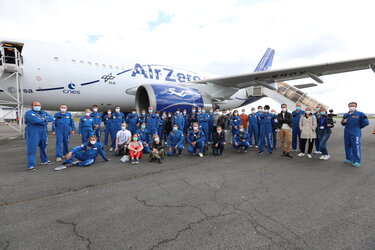Accept all cookies Accept only essential cookies See our Cookie Notice

About ESA
The European Space Agency (ESA) is Europe’s gateway to space. Its mission is to shape the development of Europe’s space capability and ensure that investment in space continues to deliver benefits to the citizens of Europe and the world.
Highlights
ESA - United space in Europe
This is ESA ESA facts Member States & Cooperating States Funding Director General Top management For Member State Delegations European vision European Space Policy ESA & EU Space Councils Responsibility & Sustainability Annual Report Calendar of meetings Corporate newsEstablishments & sites
ESA Headquarters ESA ESTEC ESA ESOC ESA ESRIN ESA EAC ESA ESAC Europe's Spaceport ESA ESEC ESA ECSAT Brussels Office Washington OfficeWorking with ESA
Business with ESA ESA Commercialisation Gateway Law at ESA Careers Cyber resilience at ESA IT at ESA Newsroom Partnerships Merchandising Licence Education Open Space Innovation Platform Integrity and Reporting Administrative Tribunal Health and SafetyMore about ESA
History ESA Historical Archives Exhibitions Publications Art & Culture ESA Merchandise Kids Diversity ESA Brand Centre ESA ChampionsLatest
Space in Member States
Find out more about space activities in our 23 Member States, and understand how ESA works together with their national agencies, institutions and organisations.
Science & Exploration
Exploring our Solar System and unlocking the secrets of the Universe
Go to topicAstronauts
Missions
Juice Euclid Webb Solar Orbiter BepiColombo Gaia ExoMars Cheops Exoplanet missions More missionsActivities
International Space Station Orion service module Gateway Concordia Caves & Pangaea BenefitsLatest
Space Safety
Protecting life and infrastructure on Earth and in orbit
Go to topicAsteroids
Asteroids and Planetary Defence Asteroid danger explained Flyeye telescope: asteroid detection Hera mission: asteroid deflection Near-Earth Object Coordination CentreSpace junk
About space debris Space debris by the numbers Space Environment Report In space refuelling, refurbishing and removingSafety from space
Clean Space ecodesign Zero Debris Technologies Space for Earth Supporting Sustainable DevelopmentApplications
Using space to benefit citizens and meet future challenges on Earth
Go to topicObserving the Earth
Observing the Earth Future EO Copernicus Meteorology Space for our climate Satellite missionsCommercialisation
ESA Commercialisation Gateway Open Space Innovation Platform Business Incubation ESA Space SolutionsEnabling & Support
Making space accessible and developing the technologies for the future
Go to topicBuilding missions
Space Engineering and Technology Test centre Laboratories Concurrent Design Facility Preparing for the future Shaping the Future Discovery and Preparation Advanced Concepts TeamSpace transportation
Space Transportation Ariane Vega Space Rider Future space transportation Boost! Europe's Spaceport Launches from Europe's Spaceport from 2012Latest

Gravity goes lunar: putting LESA to the test
Thank you for liking
You have already liked this page, you can only like it once!
Looking to the not-too-distant future when the European Service Module will propel European astronauts in the Orion spacecraft to the Gateway and on to the surface of the Moon, scientists and engineers are eagerly exploring the tools and equipment for a lunar mission.
This picture shows the Lunar Equipment Support Assembly (LESA) being tested during a partial-gravity parabolic flight. In April, ESA, along with the French space agency CNES and the German Aerospace Center DLR, sponsored a parabolic flight campaign. The campaign consisted of three flights, each featuring 31 parabolas, allowing scientists to replicate the gravitational forces of both the Moon and Mars. During those 93 parabolas, the gravity experienced by the crew was reduced to one-sixth (to simulate lunar gravity) or one-third (to mimic Martian gravity) of Earth's gravity.
Under the watchful eye and guidance of ESA astronaut and spacewalk trainer Hervé Stevenin, ESA astronaut Thomas Pesquet, who was one of the pilots of the aircraft, couldn't resist a quick try during a break – the pilots rotate every few parabolas.
The heart of the LESA investigation lies in its various transport carrier prototypes on wheels to assist Artemis astronauts during moonwalks. The mobility of these carriers, designed to transport equipment and tools, was evaluated along a four-metre path inside the aircraft.
The version of the carrier in the image is called LESA-NEST (Near-by Equipment Support Trolley), and it is designed for transporting tools and equipment.
LESA was previously tested in another unique environment: submerged during the NASA-NEEMO 23 mission in 2019. Led by ESA astronaut Samantha Cristoforetti, astronauts lived and worked underwater for nine days inside Aquarius, the world's only undersea habitat, and tested a set of geological sampling tools and the LESA support trolley to be used during future missions to the Moon.
After conquering water and air, hopes are set for a testing on the next great frontier, the Moon.
-
CREDIT
ESA/Novespace -
LICENCE
ESA Standard Licence

Your company on parabolic flights

Masked campaign

Inside a parabolic flight

Parabolic flight anyone?















 Germany
Germany
 Austria
Austria
 Belgium
Belgium
 Denmark
Denmark
 Spain
Spain
 Estonia
Estonia
 Finland
Finland
 France
France
 Greece
Greece
 Hungary
Hungary
 Ireland
Ireland
 Italy
Italy
 Luxembourg
Luxembourg
 Norway
Norway
 The Netherlands
The Netherlands
 Poland
Poland
 Portugal
Portugal
 Czechia
Czechia
 Romania
Romania
 United Kingdom
United Kingdom
 Slovenia
Slovenia
 Sweden
Sweden
 Switzerland
Switzerland
























